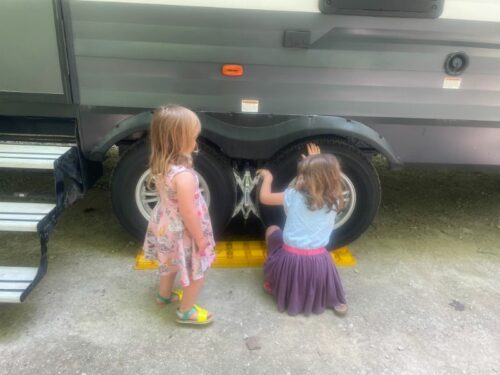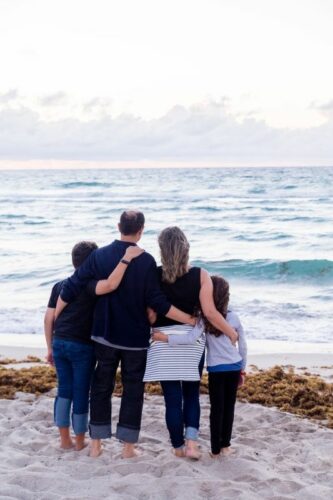Until recently, the only handicap-accessible RVs that could accommodate people with mobility issues were total custom builds. The Americans with Disabilities Act (ADA) law of 1990 only applied to residences, buildings, and facilities – not to RVs and campers! If you had trouble reaching the top shelf, you were out of luck (and out of snacks).
In the past, RV manufacturers didn’t think mass-producing disability-accessible RVs would be profitable. They delegated this responsibility to the aftermarket, like custom RV outfitters. The manufacturers preferred to produce more modular floorplans, which could be assembled quickly and shuffled around in a sales catalog.
Thankfully, this is changing. Customers have voiced their needs for campers that are more accessible, more age-appropriate, and more inclusive. Manufacturers are starting to add them to their inventory, either as upgrades to existing floorplans or as their own specific model.
If you’re in a wheelchair, walk with assistance, or just want something friendlier to your knees and hips, now has never been a better time to look for an adaptive RV!
As a residential interior design expert, I’m here to help. Let’s walk through some options for purchasing, converting, or building a handicap-accessible RV.
Who Is This Article For?
This guide is for anyone with a mobility challenge, whether you have shoulder osteoarthritis or travel in a wheelchair. My advice may need further refining on a case-by-case basis, but anyone who has physical mobility impairments can benefit from my advice and research.

THE BIG PICTURE: TIPS FOR CHOOSING AN RV FOR BETTER PHYSICAL MOBILITY
Let’s begin with the big picture.
If you’re shopping for a more accessible RV, you have three options:
- Convert a standard RV
- Purchasing dedicated Accessible RV
- Ordering a custom-built RV
Converting a Standard RV
Of all the RV types, travel trailers and 5th wheels are the easiest to convert to wheelchair-friendly layouts. That’s because they sit lower to the ground than a Class A or Class C motorhome. Towable RVs can also be purchased toy haulers, which have rear garages with full-size flip-down doors. Many toy haulers can be easily converted into mobility-friendly RV floorplans.
If you plan to convert or modify an RV, there are many quick n’ easy modifications, like installing grab handles, anti-slip tape, additional lighting, etc.
To minimize the need for manual labor, you can invest in a solar power system with an inverter. Ask a friend to help you refill propane tanks or dump your water tanks.
Width is a precious commodity in an RV. You’ll probably want a wide-body RV (102” wide), or at least a 96” wide RV with slide-outs. Very few RVs without slide-outs will be handicap-friendly! If your RV has slide-outs, try to get one where the slide-out deck sits level with the main floor.
Bathrooms can be a big problem. Avoid small neo-angle showers. And you might need to avoid 5th wheels and other multi-level layouts. Go for the largest bathroom you can!
Be honest about limitations, though. For instance, in most RV, toilets and shower drains can’t be easily relocated. Don’t bite off more than you can chew.
Purchasing a Dedicated Accessible RV Model
If you want to buy an RV off-the-lot with a handicap-accessible floorplan, then your best bet is an Accessibility Enhanced Class A Coach from a respected manufacturer from Winnebago or Dunesport.
The two biggest handicap-accessible RV manufacturers are:
- Newmar
- Winnebago
There are a few smaller companies as well, such as:
- Dunesport (custom toy haulers)
- Sportsmobile (custom Class B vans)
- Weekend Warrior Luxe (semi-custom 5th wheels)
- Harbor View (custom mobility travel trailers).
Ordering a Custom-Built RV
Obviously, purchasing a custom RV isn’t cheap. Expect to pay 3x the cost of a similar mass-produced unit. However, the quality of a custom build usually far exceeds the mass-produced stuff!
Custom manufacturers will work hand-in-hand with you to design an accessible RV.
You’ll be able to age-in-place/travel-in-place.
Expect long lead times (6-18 months). But the wait is worth it!
Popular adaptive RV outfitters include:
Remember that your RV is only one factor in the equation! Many campgrounds are not ADA-compliant. We recommend calling ahead and explaining your mobility requirements before reserving a campsite.
Resources for RVing with Disability
- Blog: Living on Life’s Terms
- RVing Accessibility Group
- The Handicapped Travel Group
- Wheel Chair Traveling
- RV Lift by Coach Lift
- FB – RVing With a Disability
ACCESSIBILITY GUIDELINES FOR PICKING A HANDICAP-ACCESSIBLE RV
For Wheelchair Accessibility
Let’s review some of the guidelines and features for RV wheelchair accessibility.
- Ramp or platform/chair lift, obviously
- Doorways and passages should be a minimum of 36” wide.
- Doors should swing out away from interior rooms wherever possible. Sliding doors may also be acceptable (unless they latch at the top).
- Lever handles or cam locks should be used in place of knobs or push buttons.
Adjustable headrests for the master bedroom - Powered lifts, elevators, and/or ramps should be available. This may require a custom upfitter for installation.
- Bathrooms must have roll-in showers or easy transfer, grab bars, and a minimum of 60” clear turning radius.
- Countertops, tables, sinks, desks, and other work surfaces must be built or adjustable to a height of between 28” to 34”, with a 19” deep overhang at minimum.
- Open floorplans are preferred to provide easier transitions between areas.
- Below-the-counter microwave oven (preferably convection).
- Dinette accessible on at least one side by a wheelchair
- A roll-under sink in the bathroom
- Switch panel accessible from a seated position
- Wheelchair security tie-downs
- Extra bonus points for adjustable-height tables and counters!
Look first for a Class A coach or a toy hauler travel trailer. Other RVs are either too small for a wheelchair-friendly layout or, in the case of a 5th wheel, the floor isn’t at a single level.
For Ambulatory/Mobility Assistance
Not all mobility issues can be solved with a wheelchair.
You may want to avoid reaching for the top shelf. Or trudging up steep stairs. Or risking a fall off an elevated platform.
Here are some guidelines for shoppers looking for a more age-appropriate RV layout:
- Upper cabinets no more than 12” deep
- Dinette or chair seat height should be around 18 inches
- Toilet seat height should be 17-20 inches
- Maximum ceiling height of 80”
- Maximum step riser height of 7”
- Firm upholstery cushions
- Extra-long, flexible shower wand
- Flip-down seat or chair in shower
- Bonus points for a Sleep Number bed!
BEST RVS FOR BUYERS WITH MOBILITY CHALLENGES
Newmar
Newmar was the first RV manufacturer to offer wheelchair-accessible floorplans, and they have three Class A models to choose from: the Bay Star 3811, the Kountry Star 4011, and the Dutch Star 4311.
As with any RV floorplan, there are slight differences in layout and amenities, but all three Newmar accessible plans offer roll-in showers, pull-under sinks and dining tables, powered lifts, lowered sinks and appliances, and system controls mounted lower on the wall.

One of the nicer options Newmar offers is a built-in washer and dryer to eliminate the need to find wheelchair-accessible laundromats.
Winnebago
Among the most well-known names in recreational vehicles, Winnebago offers three different floorplans for wheelchair users: the Adventurer AE 30T, the Inspire 34AE, and the Roam U59RA. Both the Adventurer and the Inspire are Class A motorhomes, but the Roam is a Class B.

As with the Newmar models, the Winnebago AE (Accessibility Enhanced) models offer powered lifts, wider spaces, roll-in showers (Class A only), and lowered counters, appliances, and controls.

The floorplan of the Winnebago Roam Class B van shows how well a small space can still accommodate a wheelchair user. While the wet bath is not a roll-in version, the wheelchair tiedowns beside it offer a stable platform from which to transfer into the bath.
The sofa automatically converts to a bed and back at the touch of a button, and the kitchen counter is built at a lower height. There is no built-in cooktop, but many Class B owners have single induction or gas burners tucked away in a drawer or cabinet that they can bring out as needed. A dinette table folds down against the wall and out of the way when not being used.

A great feature of the Winnebago Roam is that the upper cabinets are mounted on extendable slides, allowing them to be pulled down for easy access.
One of the major advantages of Class B vans in general – and Accessibility Enhanced vans in particular – is that they fit into standard parking spaces, which makes it easier both to find camping spots and to run errands around town.
Harbor View
Harbor View offers seven different wheelchair-accessible floor plans in a travel trailer. They are:
- HV-24CKRB
- HV-28CKRB
- HV-29CKRB
- HV-33CKWT
- HV-36CKBB
- HV-36CKBH
- HV-36CKWT
Travel trailers are extremely popular with the RV crowd because they can be towed by a truck or SUV. This allows them to be built longer, so they have more space. They are also handy because you can set up at a camping spot and unhitch, so you can drive around without having to move the trailer again. Travel trailers also tend to be cheaper, so they’re good choices for families that may not be using them every single week.
Another advantage to travel trailers – and fifth-wheels and toy haulers, for that matter – is that the tow vehicle is separate from the living space. If there’s a maintenance issue, you won’t be left without your home and your vehicle at the same time.
The Harbor View wheelchair accessible floorplans offer wide doorways, powered lifts, and very large bathrooms with roll-in showers.


As you can see, a travel trailer can offer a lot of possible layouts. The Harbor View floorplans all have the same general wheelchair-accessible features, and differ mainly in how many people they can sleep. As with the Class A RVs, slide-outs are used to increase floor space.
Dune Sport
Arizona-based manufacturer Dune Sport specializes in custom Toy Haulers. If you’re new to RVs, a Toy Hauler is a travel trailer with a ramp in the back and space inside to park vehicles such as 4x4s, motorcycles, golf carts… even full-size cars in some cases. The ramp makes it very easy for wheelchair users to enter the vehicle. Powered lifts are also available, as are lowered decks.

A shorter Toy Hauler, but still has all of the necessities, if not a lot of storage.

A longer model, with a larger bathroom at the front, and sleeping space for 5 to 6 people. More if they’re friendly.

One of the longest Toy Haulers, with tons of sleeping space, a separate dining area, and a unique corner shower in the bathroom.
If you’re wondering how there can be a bed in front of the access ramp…

Powered bed lifts can be found in every class of RV. This particular Dune Sport Toy Hauler combines a standard queen-size bed with two lower beds – also motorized – to create a bunk bed setup, leaving more space for cooking utilities and the bathroom area at the front of the trailer.
The same model with other furniture options and a different kitchen layout. The queen bed is out of frame against the ceiling.
Having a rear access ramp doesn’t mean you can’t get a powered lift at the side door, too.
Dune Sport offers fully customized floor plans for their Toy Haulers, so you are sure to get the amenities, layout, and access that work best for you.
No matter which type of RV or travel trailer you are considering, there are models that are wheelchair-accessible.
- If it’s the luxury you’re looking for, the Newmar and Winnebago Class A RVs are a great choice.
- If you have a large family and/or a lot of gear, a Harbor View travel trailer or Dune Sport Toy Hauler might be the camper you need.
- And anyone looking for a Class B van should check out the Winnebago Roam.
These aren’t the only RV makers offering accessibility enhanced campers by any means – there are other shops that will happily design and build a 100% custom vehicle from the chassis up based on your specific needs – but these are some of the best known manufacturers, so they’re a good place to start.
Remember, RV models are always being tweaked and replaced, so you may not see these specific campers when you start looking. The good news is that with these manufacturers leading the way, others will jump on board, and you’ll have even more to choose from!
Happy adventuring!
Patrick has visited 11 countries and 35 of the 50 states. He has racked up thousands of miles in RVs of every class, including a hand-crafted Romani vardo. His retirement plan is a custom Class B and a generic cat, the primary goal being to pick up those last 15 states.
-
Patrick Colemanhttps://changingears.com/author/patrick-coleman/
-
Patrick Colemanhttps://changingears.com/author/patrick-coleman/
-
Patrick Colemanhttps://changingears.com/author/patrick-coleman/
-
Patrick Colemanhttps://changingears.com/author/patrick-coleman/










